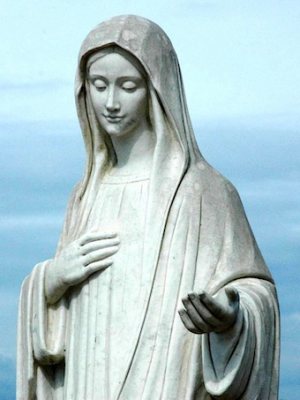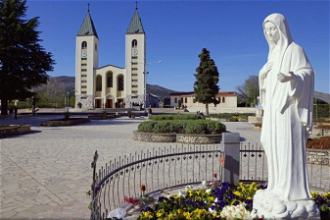Cardinal: With new Norms it will be easier to decide on Medjugorje

Statue of Our Lady at Medjugore - Wiki Image
In an interview yesterday with L'Osservatore Romano, the Prefect of the Dicastery for the Doctrine of the Faith, Cardinal Víctor Manuel Fernández, reflected on the impact of the Vatican's new Norms discerning presumed supernatural phenomena on the "Medjugorje case".
The Cardinal said: "Regarding Medjugorje, no conclusion has been reached yet, but with these guidelines, we believe it will be easier to proceed and reach a conclusion." He added that "for other cases that have been present at the Dicastery for many years, these guidelines will make it easier to arrive at a prudential conclusion… In many cases, these phenomena have grown well and normally. Sometimes a phenomenon can be easily managed without issues, producing positive outcomes: this has happened in most sanctuaries. Many frequently visited sanctuaries by the faithful originated from a similar experience. There has never been a declaration, neither from the bishop nor the Dicastery, and they have grown normally without problems as popular devotion."
The Cardinal explained, "a beautiful phenomenon can grow" without requiring "a declaration of supernatural origin. In the cases of Lourdes, Fatima, and Guadalupe, their enormous growth did not depend on a declaration of supernatural origin."
Answering another question on Medjugorje the Cardinal said: ".. I haven't read the material available at the Dicastery, I know some details, but we need to study to reach a conclusion with these new norms. Keep in mind that a phenomenon can be considered good, not dangerous at the origin, but it may have some issues in its later development. Therefore, sometimes a declaration needs to clarify these different stages: that's a distinction we need to consider. And then, suppose there was a green light, a 'nihil obstat,' we might also need to clarify that some details should not be taken seriously. If I remember correctly, the Madonna there was giving orders, setting the schedule, the place, what the bishop should do, etc. That needs to be clarified."
The voices and testimonies of the devotees of the Gospa (the Madonna in Croatian) - are the strongest narrative, enduring for almost 43 years, of the 'Medjugorje phenomenon.' Until June 24, 1981, the name of this small village in Bosnia and Herzegovina (then in former Yugoslavia), in the diocese of Mostar-Duvno, was known only to those living in the region. Today it is a spiritual reference point, as well as a popular pilgrimage destination, for many people.
Two girls, aged 15 and 16, Ivanka Ivanković and Mirjana Dragicević, reported seeing a female figure on a small cloud while walking on a rocky hill called Podbrdo at 4pm on June 24, 1981. Shortly after, Vicka Ivanković, Ivanka's cousin, joined them. All three claimed to have seen the mysterious figure again, this time with a child in her arms, which they immediately identified as the Virgin Mary. Ivan Dragičević, Jakov Čolo, and Marija Pavlović were the other three young people who formed the group known as the "visionaries." The six young people spoke of apparitions of Mary, who introduced herself as the "Queen of Peace" with a message fundamentally calling for reconciliation and conversion.
From that afternoon and those accounts - on a remote piece of land soon to experience a bloody war - a story began that has left a mark on the life of the Church, reaching millions of people in various ways: through conversions, with long lines at confessionals and extraordinary participation in Eucharistic adorations, as well as through strong scepticism and staunch opposition.
In response to the growing experiences related to Medjugorje, in 1991, the bishops of Yugoslavia stated in their 'Zara Declaration' that, based on investigations conducted up to that point, it was not possible to affirm that these were apparitions and supernatural phenomena.
To clarify the facts of Medjugorje, Pope Benedict XVI established an International Commission of Inquiry on March 17, 2010, within the then Congregation for the Doctrine of the Faith. The Commission, presided over by Cardinal Camillo Ruini, collected and examined "all the material" related to the issue over 17 meetings and presented a detailed report to the Pope, including recommendations on "the supernatural nature or not" of the apparitions, and suggesting the most appropriate pastoral solutions.
The Commission reviewed all documentation available in the Vatican, at the Medjugorje parish, and in the archives of the former Yugoslavia's secret services. They interviewed the alleged "visionaries" and witnesses and conducted an on-site inspection in Medjugorje in April 2012. This work continued for almost four years, concluding on January 17, 2014, when the final report was delivered to Pope Francis.
Speaking during a press conference on the plane returning from the apostolic trip to Fatima on May 13, 2017, Pope Francis said: "all apparitions or presumed apparitions belong to the private sphere, they are not part of the Church's public ordinary Magisterium."
He specifically referenced the Commission of Inquiry's work, distinguishing three aspects: "Regarding the first apparitions, when [the 'visionaries'] were children, the report more or less says that further investigation is needed. About the presumed current apparitions, the report has its doubts," and "thirdly," the Pope noted, "the core of the Ruini report: the spiritual fact, the pastoral fact, people who go there and convert, people who encounter God, who change their lives. For this, there is no magic wand, and this spiritual-pastoral fact cannot be denied."
With this understanding, on February 11, 2017, the Pope assigned Polish Archbishop Henryk Hoser the mission of "special envoy of the Holy See" to "gain deeper knowledge of the pastoral situation" in Medjugorje and, "especially, the needs of the faithful who go there in pilgrimage" to "suggest possible pastoral initiatives for the future." This mission was of an "exclusively pastoral" nature.
On May 31, 2018, without addressing the specific issues related to the presumed apparitions, Pope Francis appointed Archbishop Hoser as Apostolic Visitor with a special character for the parish of Medjugorje, for an indefinite period and at the Holy See's discretion. This role was also "exclusively pastoral," in continuity with the mission of the Holy See's special envoy that he had completed. "The mission of the apostolic visitor," the Holy See's Press Office announced, "aims to ensure a stable and continuous accompaniment of the parish community of Medjugorje and the faithful who go there in pilgrimage, whose needs require particular attention."
In an interview with Vatican News, Archbishop Hoser explained that pilgrims from around the world come to Medjugorje "to encounter Christ and His Mother." He emphasized that "the Marian path is the most certain and safest" because it leads to Jesus. In Medjugorje, the faithful focus on the Holy Mass, the adoration of the Blessed Sacrament, and frequent participation in the Sacrament of Penance. For the Archbishop, this constituted a truly "Christocentric" worship, lived in closeness to the Virgin Mary, venerated with the title of "Queen of Peace."
On May 12, 2019, Archbishop Hoser and the Apostolic Nuncio to Bosnia and Herzegovina, Archbishop Luigi Pezzuto, announced Pope Francis's decision to authorize pilgrimages to Medjugorje, which can now be officially organized by dioceses and parishes and no longer take place only in a "private" form as previously indicated by the Congregation for the Doctrine of the Faith.
The then interim director of the Holy See Press Office, Alessandro Gisotti, clarified that the Pope's authorization should be accompanied by the caution "to avoid that these pilgrimages are interpreted as an authentication of the known events, which still require examination by the Church. Therefore, it is to be avoided that such pilgrimages create confusion or ambiguity from a doctrinal point of view. This also applies to pastors of any rank who intend to go to Medjugorje and celebrate or concelebrate there in a solemn manner."
Gisotti also pointed out that "considering the significant flow of people and the abundant fruits of grace that have sprung from it, this provision falls within the particular pastoral attention that the Holy Father has intended to give to this reality, aimed at fostering and promoting the fruits of good." Thus, the apostolic visitor "will have greater ease in establishing relations with the priests in charge of organizing pilgrimages to Medjugorje, as reliable and well-prepared persons, offering them information and guidelines to conduct these pilgrimages fruitfully."
On November 27, 2021, Pope Francis appointed Archbishop Aldo Cavalli as the successor to Archbishop Hoser - who died on August 13 - the new Apostolic Visitor, responsible for the pastoral care of the pilgrims travelling to Medjugorje.


















